Orv's ScriptNode+SNEX Journey
-
I've gotta start documenting some of my experiments, tests, failures, and successes, when it comes to ScriptNode's and SNEX, and interfacing with the Hisescript interface side of things.
So I thought I'd start a thread on it, so hopefully people can learn from my idiocy, and I can have something to reflect back on when I'm stuck.
So.... lesson 1: Synth.getAudioSampleProcessor.
This is a useful method for accessing the sample slot of a module, and generally if you're using the built in sampler or audio player modules, you won't run into this issue. But I just did, and it stumped me for ages, because of a misleading error message.
So here it is - if you are trying to do this with a Scriptnode Synthesiser, you need to be sure that your Scriptnode Synthesiser meets these conditions:
- It must have a node in it that contains some form of AudioFile: file_player, stretch_player, granulator, or the snex_node nodes.
- Your node from this list must be set to use an External AudioFile Slot.
If these conditions aren't met, then when you try to make a call to Synth.getAudioSampleProcessor, the console will return the following error:
Interface:! Line 3, column 42: Scriptnode Synthesiser1 was not found. {SW50ZXJmYWNlfG9uSW5pdCgpfDgwfDN8NDI=} Master Chain:! Line 3, column 42: Scriptnode Synthesiser1 was not found. {SW50ZXJmYWNlfG9uSW5pdCgpfDgwfDN8NDI=}This error actually is not that useful. It really should say that the AudioSampleProcessor was not found in my opinion.
Here is a screenshot of a scenario where you could get this:
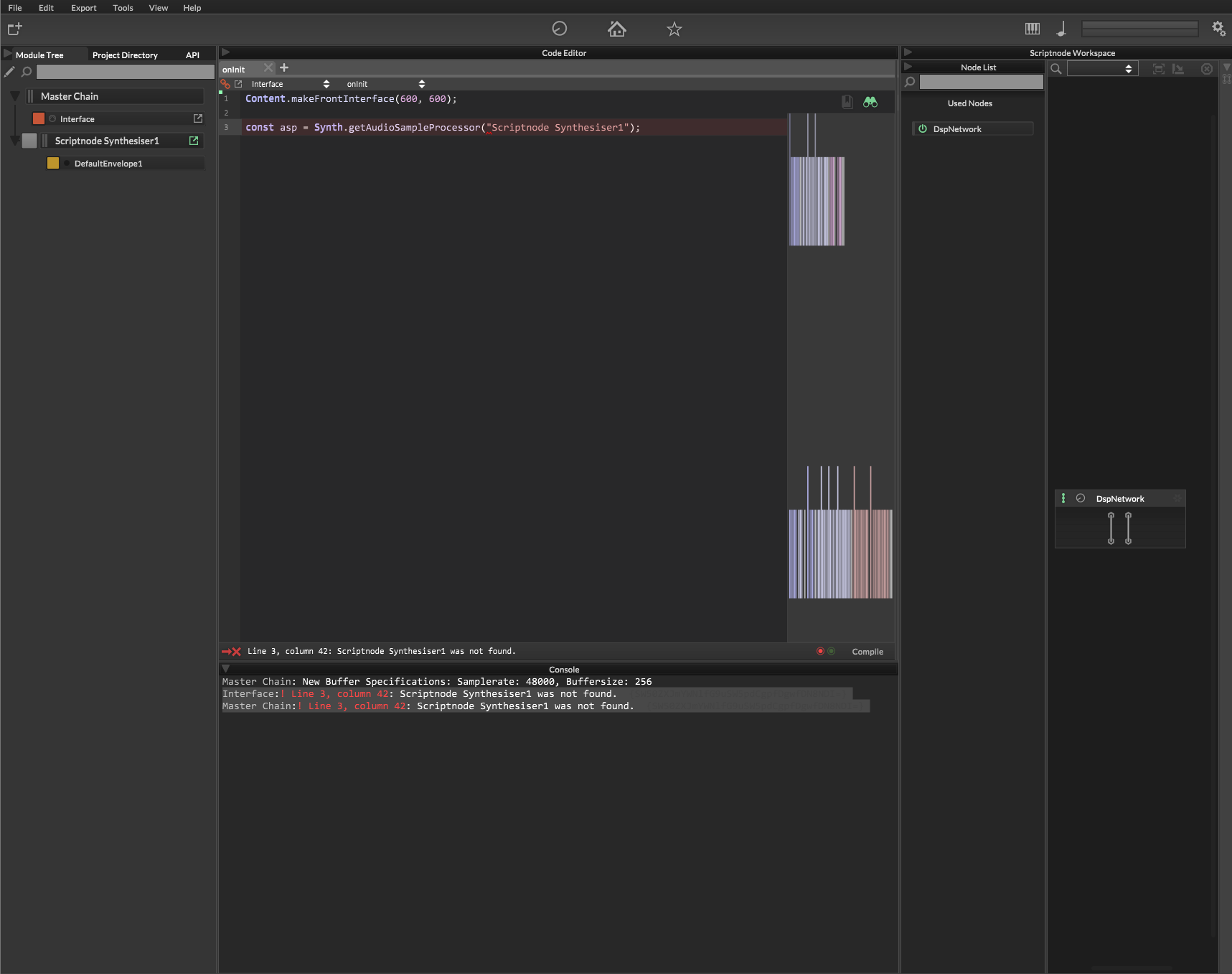
You'll notice that I have a Scriptnode Synthesiser in my module list, and it has a DspNetwork assigned to it. However the network is completely empty.
Now if I add a file_player node:
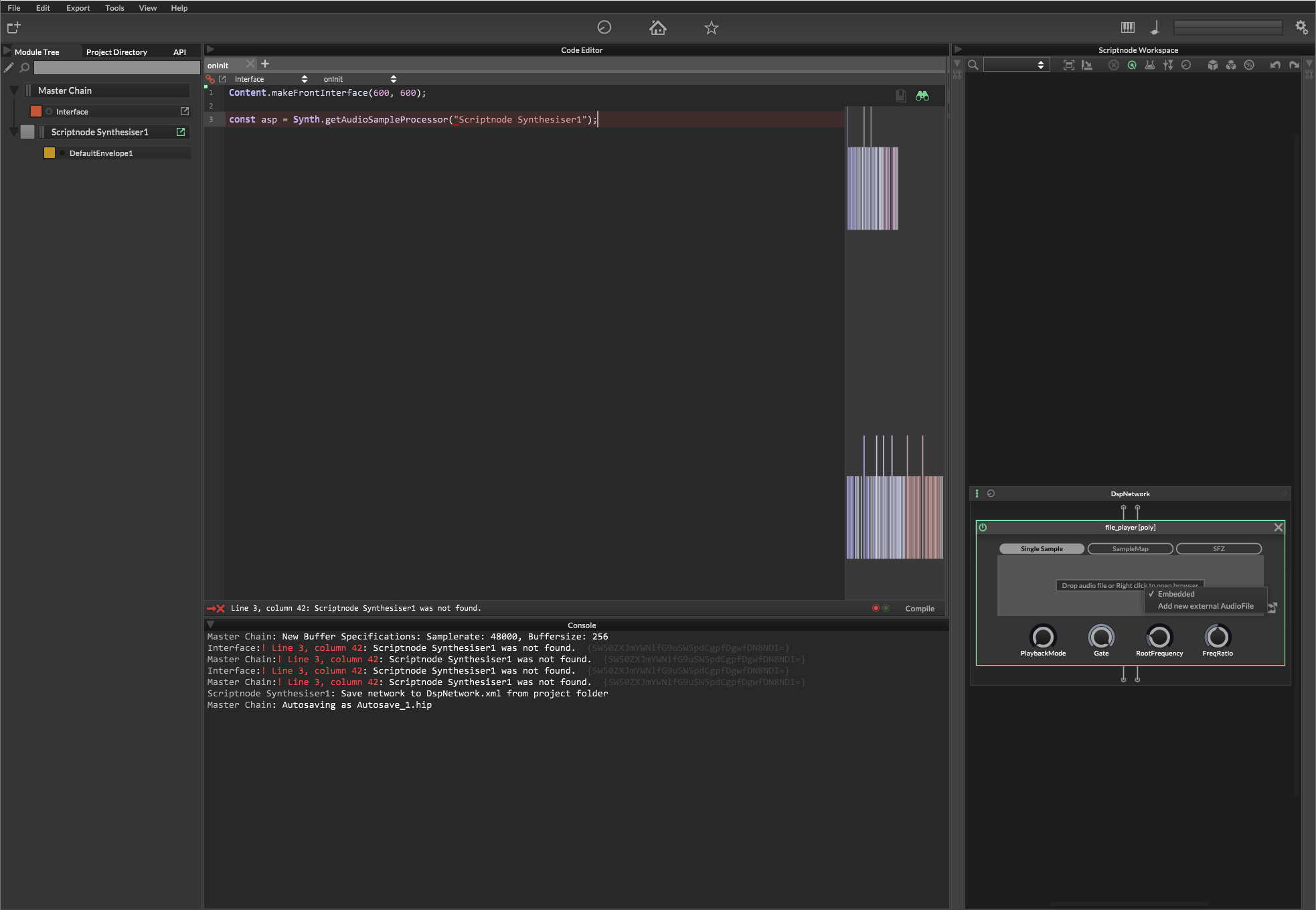
We still get the same error, because the file_player node does not have an external file slot added to it.
If we load a file to the embedded slot (bad practice imho) this also makes no difference:
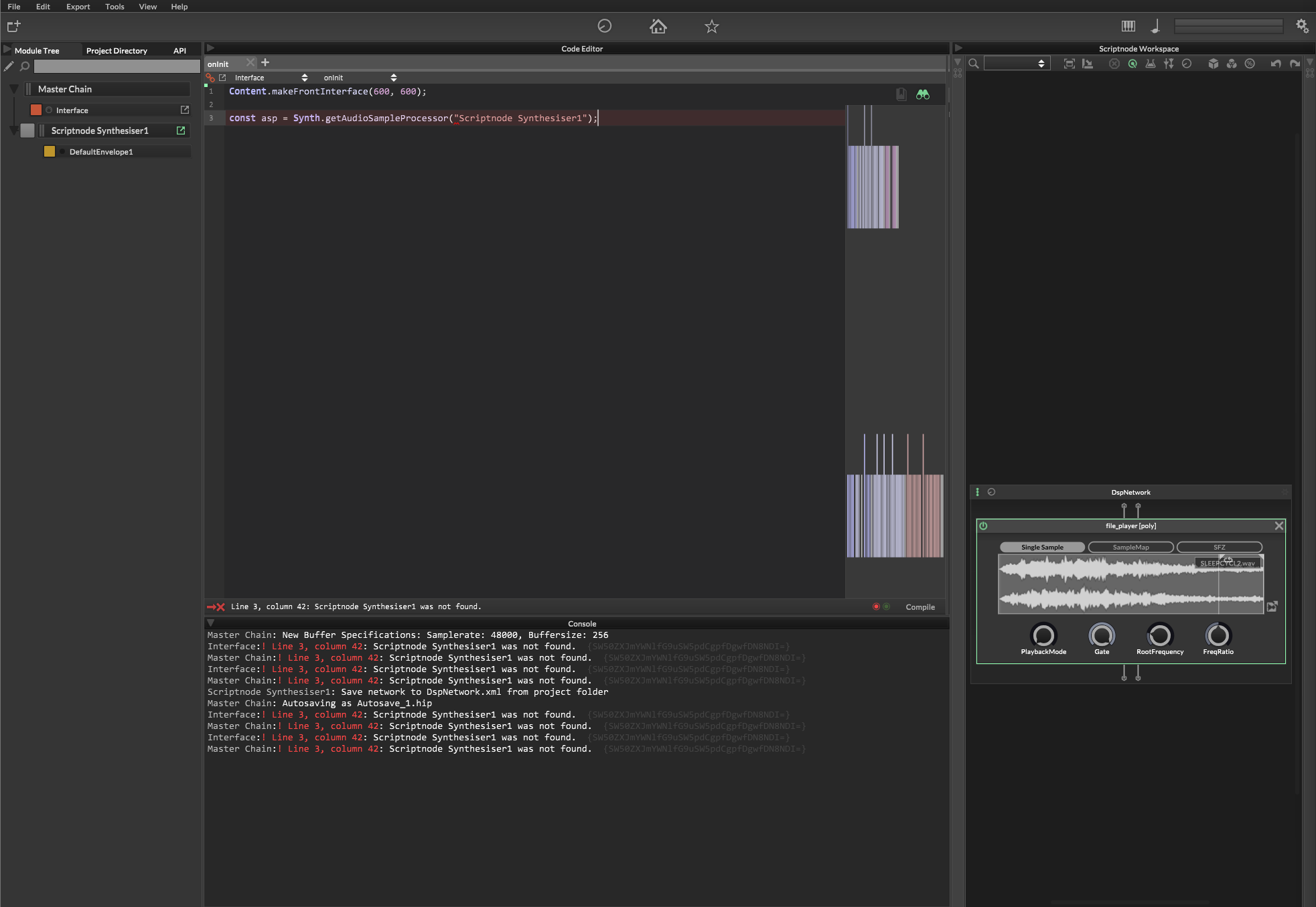
We still cannot resolve the AudioSampleProcessor.
Finally... if we add an external slot, even when it is empty, we get the AudioSampleProcessor reference that we were looking for:
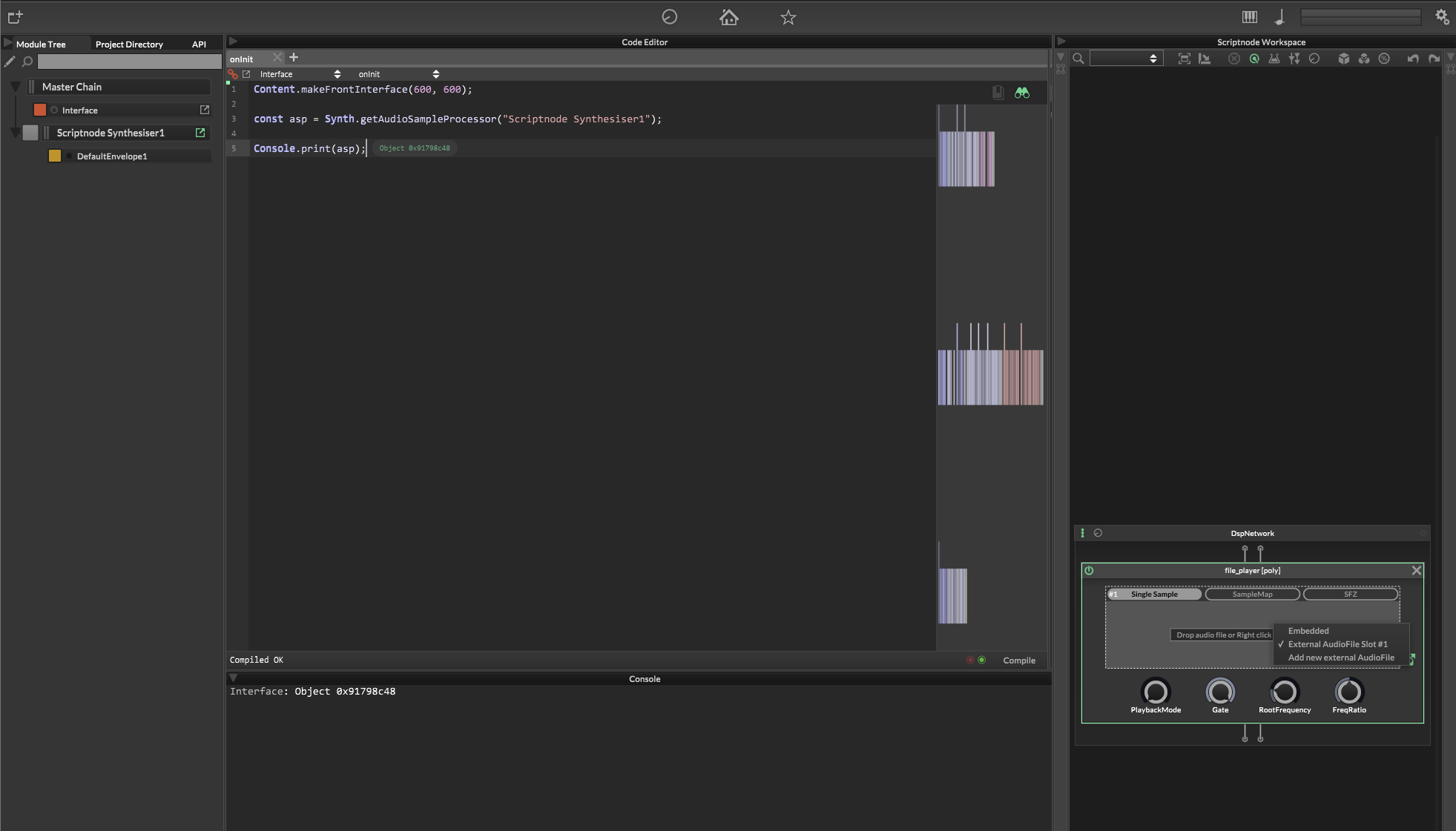
Something to watch out for.
-
Lesson 2: loading samples.
Loading samples into an AudioSampleProcessor can be done by running a .setFile() call on the retrieved AudioSampleProcessor object.
However, on Windows, it is very easy to make this crash.
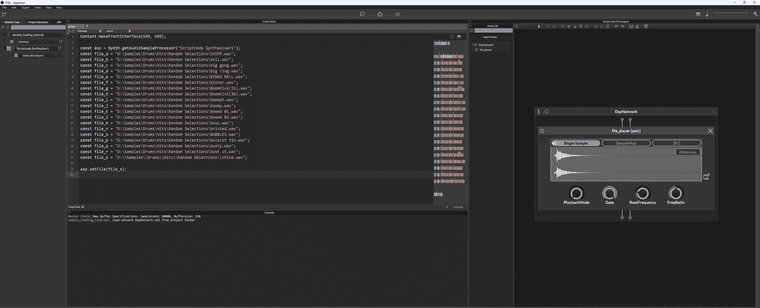
Consider the above image. The backslashes in files a-r, will cause HISE to crash to the desktop if you try to load any of those files into the AudioSampleProcessor.
file_s has double backslashes, and this does not seem to crash.
Another way to ensure the file loads, is to just use forward slashes:
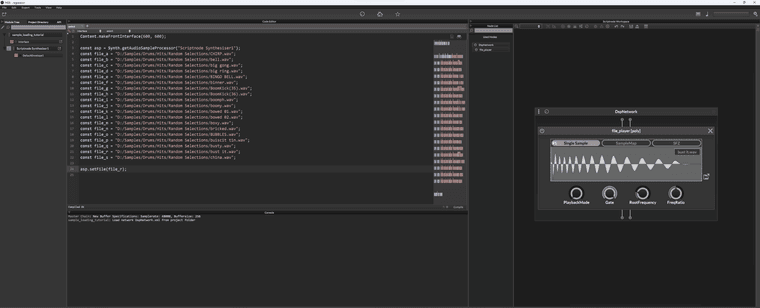
-
Lesson 3 - using the SNEX node with sample content.
This one is something I'm still getting my head around. @Christoph-Hart kindly provided a one shot SNEX node demo, which you can find by going to the example snippet browser in the Help menu:
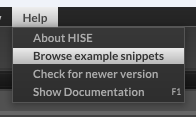
This will open a whole new window where you can experiment with snippets. Maybe I'll go over the specific snippet in another post, but for this one... we're starting fresh, and we're going to just do the basics.
So.... here we have a basic interface script that gives us some file const references, an AudioSampleProcessor retreiving the AudioSampleProcessor from a Scriptnode Synthesiser in our module tree. That synthesiser has a DspNetwork assigned to it:
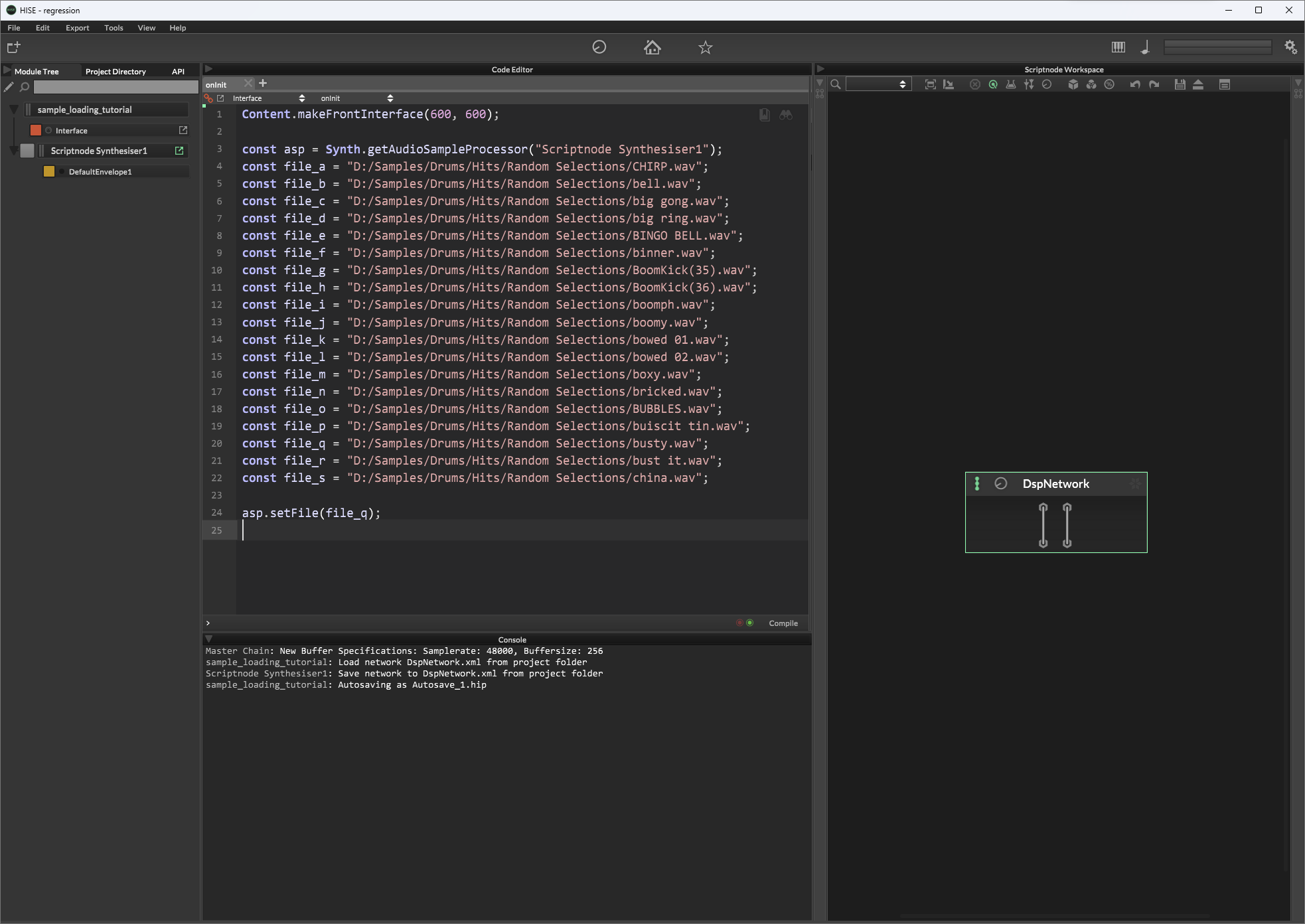
Right now, if we run the code... it will fail to find the AudioSampleProcessor as explained above. Let's add a SNEX node:
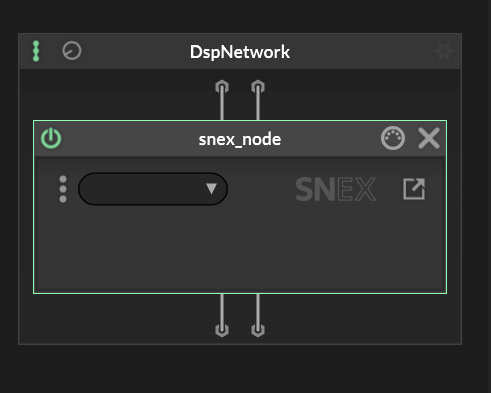
When you do this, it will be blank. You will need to click the three dot menu icon and choose "create new file" - strangely enough, you have to do this even when creating an embedded network. But fine. Let's do it:

We need to give it a name:
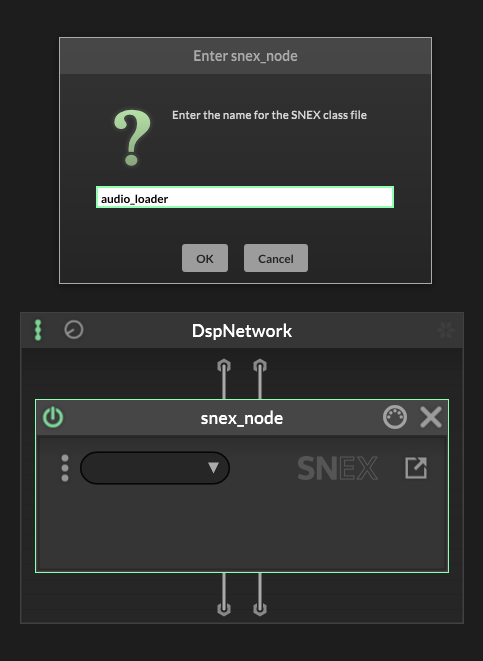
At this point, the node becomes active, indicated by the green highlight text:
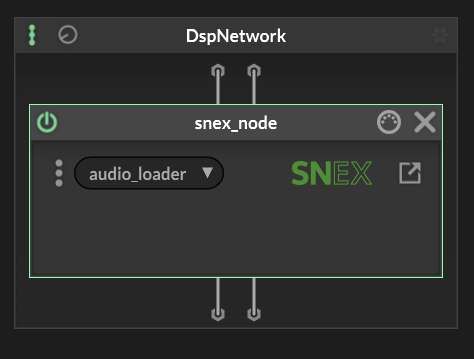
Now if you open the same menu, you get more options:
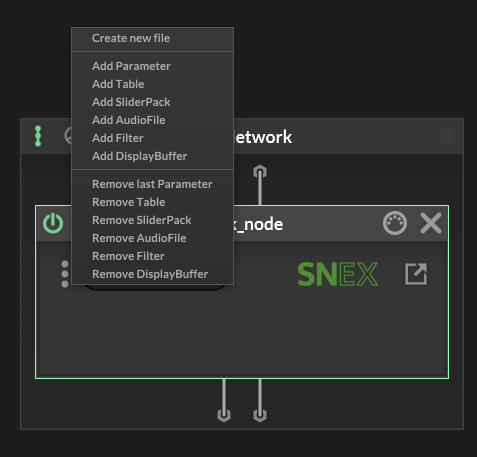
We're going to select 'Add AudioFile':
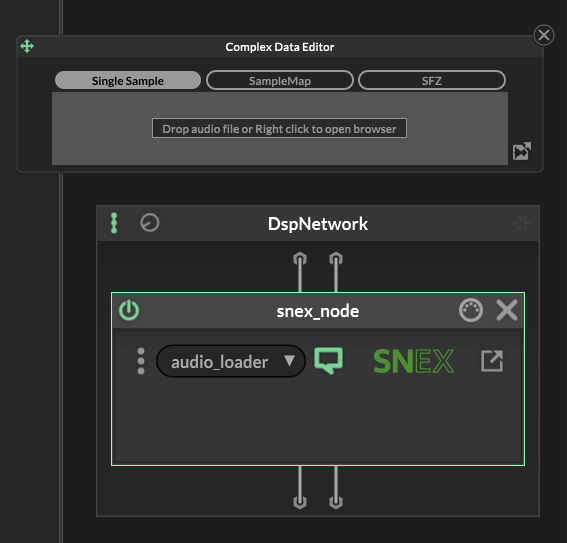
You can see that now there is an extra icon in the SNEX node, which opens the AudioFile "Complex Data Editor" panel.
We can add an External AudioFile Slot using the icon on the right hand side:
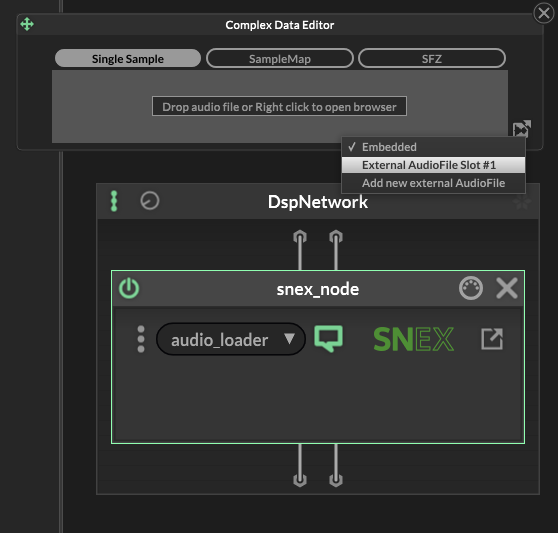
And now you can see that the data editor will display whatever sample you assign to that AudioSampleProcessor from your script:

So here we see that file_r has been loaded into the buffer, and if we wanted to do file_f instead we could change the code to do that:
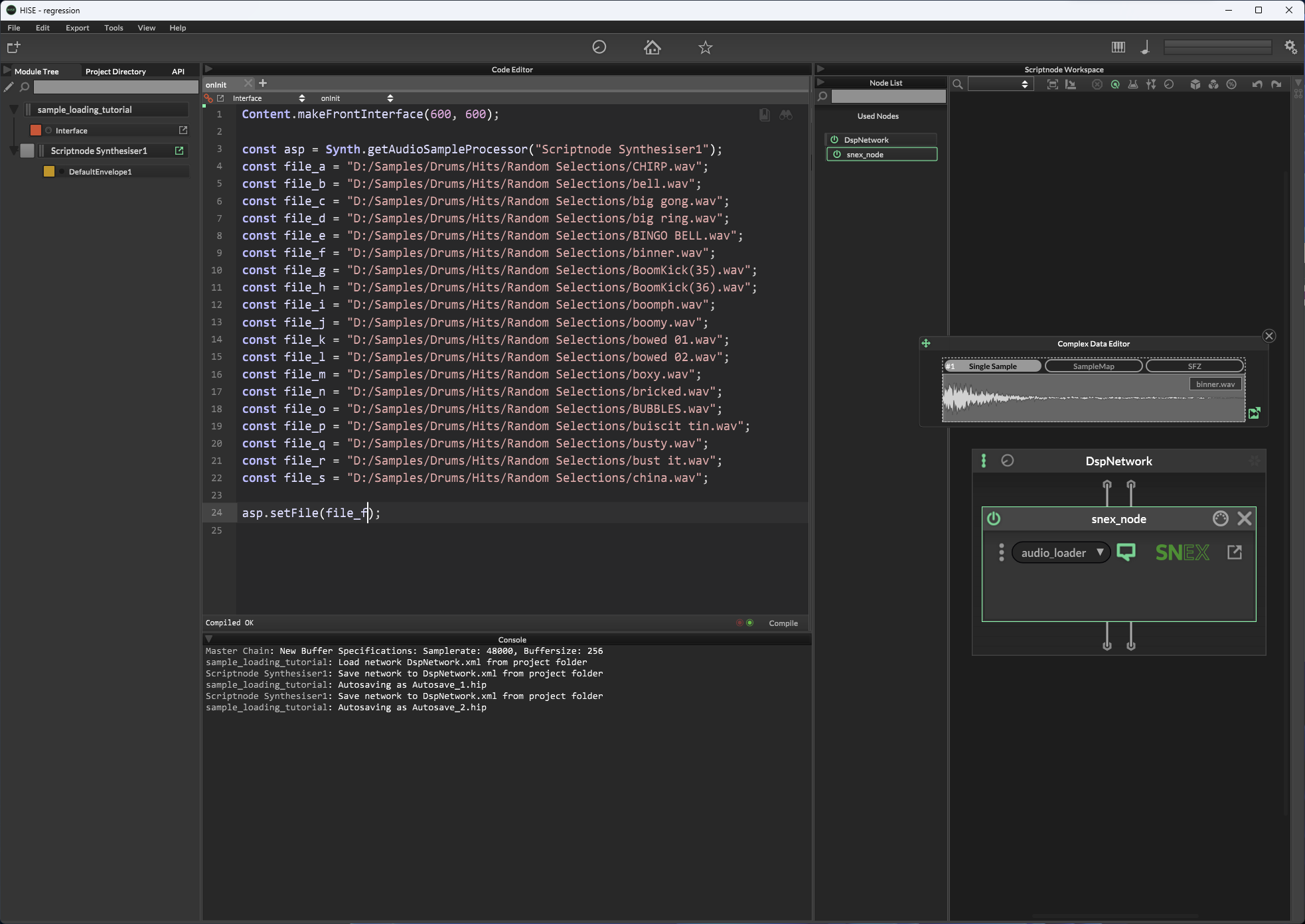
Note - you will not be able to playback the audio at this stage, as your SNEX code will be completely empty. If you click the icon on the right side, it will open the code editor for this SNEX node:
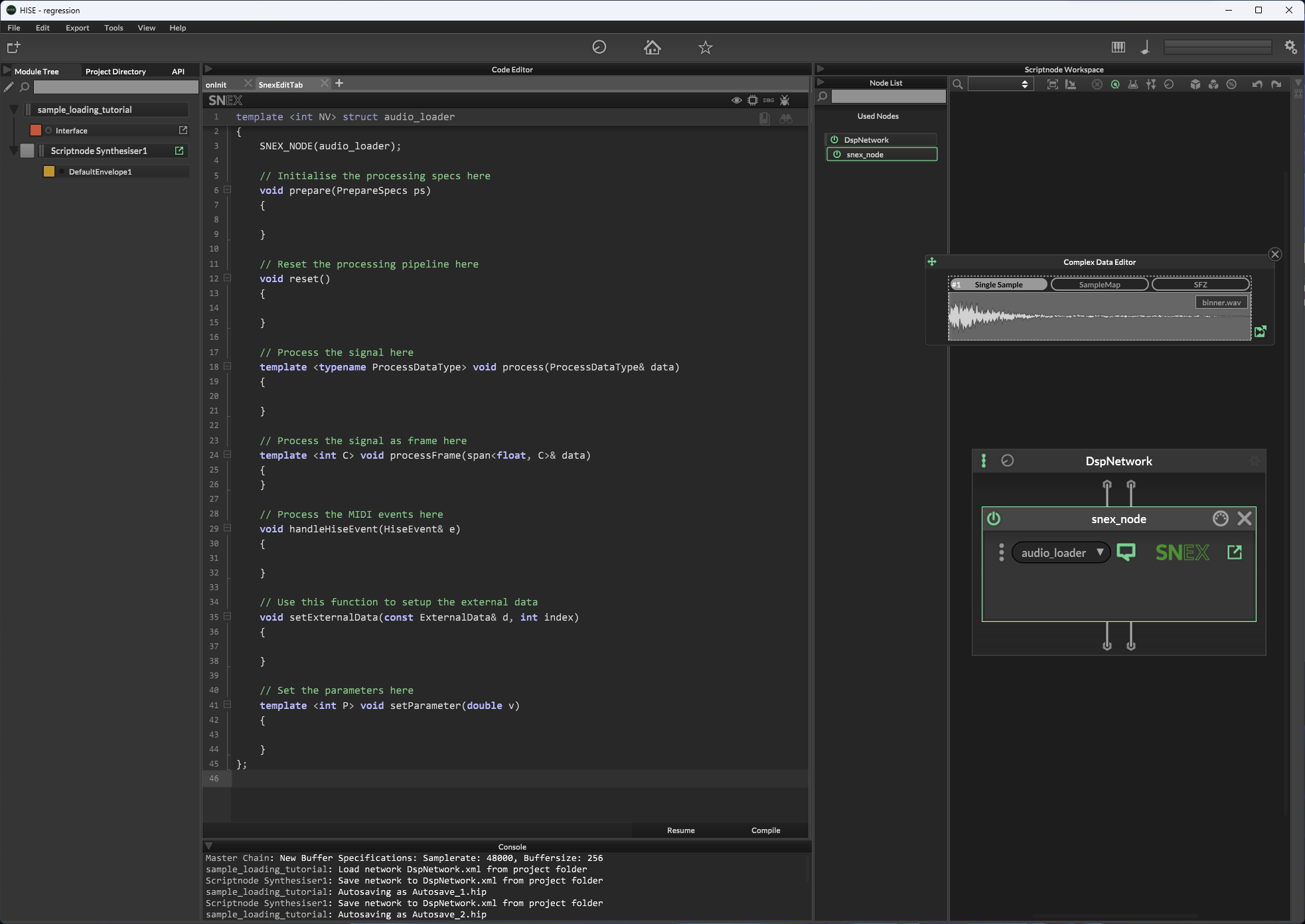
So whilst the data is loaded, our code isn't doing anything with it.
-
This post is deleted! -
@d-healey I don't mean to be rude, but please don't distract from the purpose of this thread. Beautiful code and efficient code isn't the point here.
The point is to demonstrate how the API works, and for there to be a resource for people who come along in the future looking to do sample loading from their scripts, and looking to do advanced things in ScriptNode or SNEX.
I know full well that in a real world scenario, you wouldn't specify a bunch of files each as an individual const, and you'd put them in a key value pair inside of an array, or perhaps a function acting as a meta-object.
-
Lesson 4 - SNEX Node layout.
I'm still wrapping my head around how the SNEX node works.
The first thing to note is, SNEX code does not support strings. The documentation for HISE does make this clear, but if you haven't seen it yet... then I've told you again! Here's the docs link:
https://docs.hise.audio/scriptnode/manual/snex.html#getting-startedAs the docs say:
The Scriptnode Expression Language (SNEX ) is a simplified subset of the C language family and is used throughout scriptnode for customization behaviour.Which means that most of the syntax you're used to when writing interface scripts, is just not going to be the same. There are some overlaps however - Console.print() is still used in SNEX scripts. However, print messages only get logged to the console when you put the SNEX node into debug mode. Which you can do by clicking this button:

From what I can tell, by default we have the following methods:
- prepare
- reset
- process
- processFrame
- handleHiseEvent
- setExternalData
- setParameter
Each one of these methods has a purpose. I'm still experimenting to figure out what those are, but here's what I've come up with so far:
- prepare
This is called when you compile or initialise your SNEX node, and it seems to run for each audio channel. I would guess this is meant to setup global parameters like sample rate and block size. Things that do not change from voice to voice. - reset
This is called when you trigger a voice, in my case from midi. When using a ScriptNode Synthesiser, the midi passes into the node automatically. This is where you would initialise variables that can hold different values from voice to voice, but that must start out with the same default value each time. - process
Haven't quite figured this one out yet. - processFrame
Haven't quite figured this one out yet. - handleHiseEvent
This is called when you trigger a HiseEvent - typically a midi event. This is where you would parse out your midi notes, velocities, controllers, and program changes; any midi data really. - setExternalData
This is called whenever there is a change to the external data. In our case, that would be the AudioFile we added in previous steps. So for example if you went to the complex data editor for the External AudioFile Slot (in the node editor) and loaded a new file, this method would get called. This is where you would resize any arrays that you're using to store the sample data, for example. - setParameter
This is called whenever a parameter inside the SNEX node is adjusted. You can parse the parameters out by using if statements and checking P against 0, 1, 2, 3, etc, depending on how many parameters you actually have.
SNEX has some hard-coded variable names, most of which I don't know yet. But a valuable one is "ExternalData". Consider this code:
template <int NV> struct audio_loader { SNEX_NODE(audio_loader); ExternalData data; // Initialise the processing specs here void prepare(PrepareSpecs ps) { } // Reset the processing pipeline here void reset() { } // Process the signal here template <typename ProcessDataType> void process(ProcessDataType& data) { } // Process the signal as frame here template <int C> void processFrame(span<float, C>& data) { } // Process the MIDI events here void handleHiseEvent(HiseEvent& e) { } // Use this function to setup the external data void setExternalData(const ExternalData& d, int index) { data = d; } // Set the parameters here template <int P> void setParameter(double v) { } };Most of it doesn't do anything. But we have established that ExternalData is linked to a variable called data. We can also see this in the data table view:
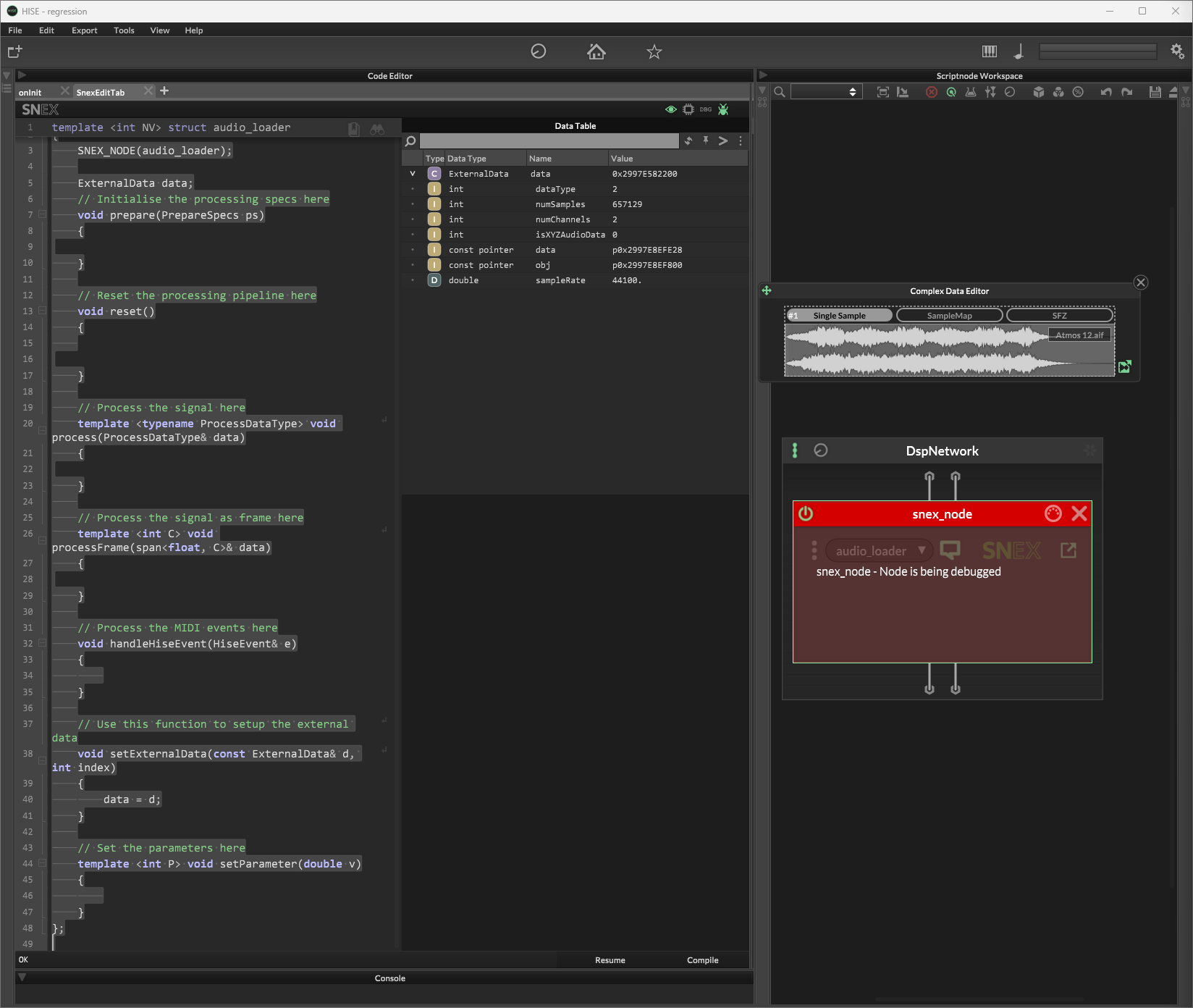
Notice how ExternalData is a Data Type, and it is named data. Also notice how it has a variety of sub attributes - dataType, numSamples, numChannels, etc.
Let's swap out the file loaded in the AudioFile editor:
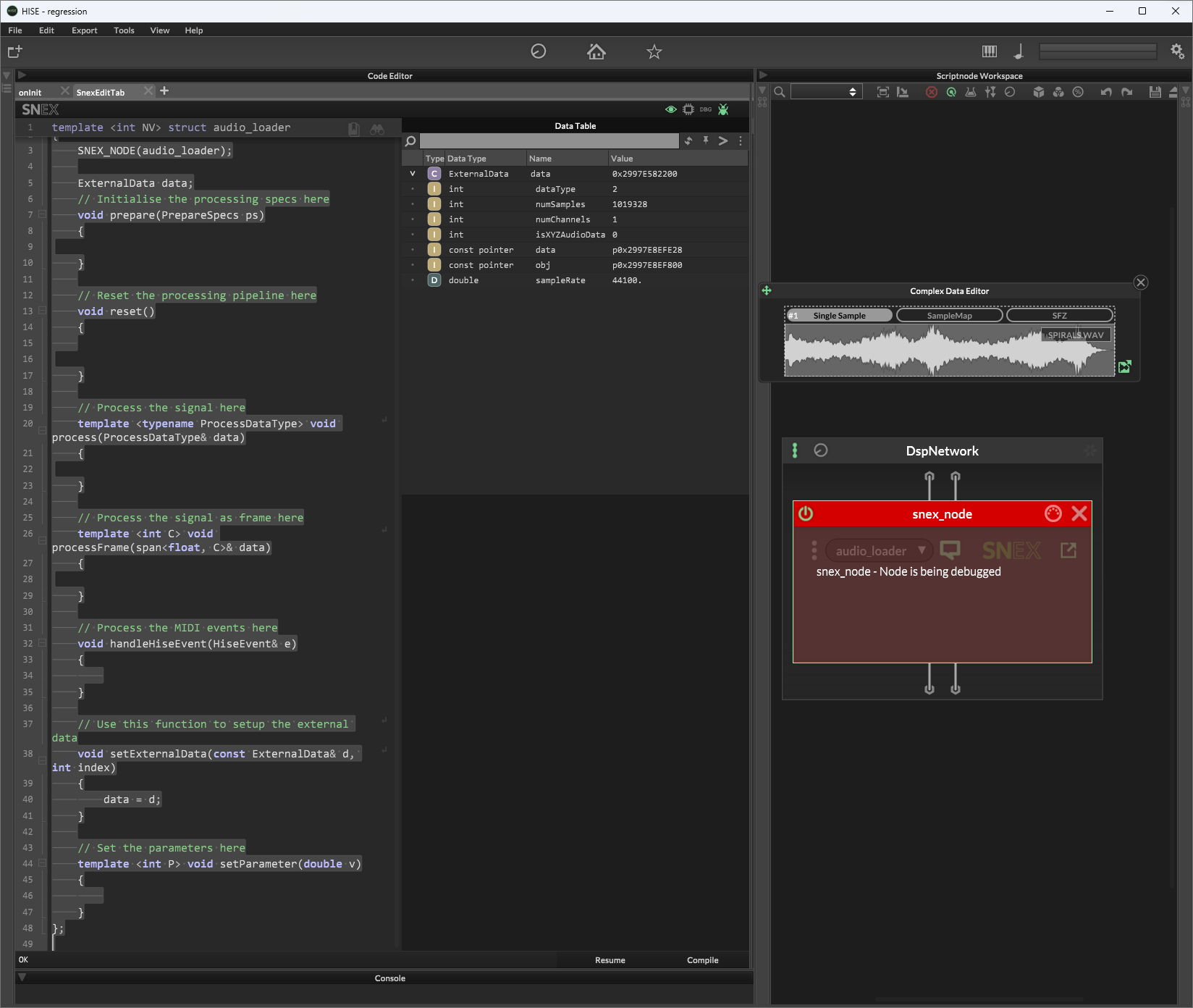
Notice how numSamples has updated, and also numChannels.
Back to the code:
// Use this function to setup the external data void setExternalData(const ExternalData& d, int index) { data = d; } // Set the parameters here template <int P> void setParameter(double v) { }The data variable we established as ExternalData at the top of the script, is now actually having the data pushed into it by the setExternalData method - which has two inputs; "d" and "index".
This shows the very very basics of getting sample data into a SNEX script. But we're still not doing anything with it yet.
-
Lesson 5 - SNEX code in a bit more detail.
So I'm by no means an expert in C or C++ - in fact I only just recently started learning it. But here's what I've sussed out in regards to the HISE template.... and template is exactly the right word, because the first line is:
template <int NV> struct audio_loaderSomewhere under the hood, HISE must be setup to send in an integer into any SNEX node, that integer corresponding to a voice. NV = new voice perhaps, or number of voices ????
The line above declares a template that takes this NV integer in, and creates a struct called audio_loader for each instance of NV. Indeed we can prove this by running the following code:
template <int NV> struct audio_loader { SNEX_NODE(audio_loader); ExternalData data; double note = 0.0; // Initialise the processing specs here void prepare(PrepareSpecs ps) { } // Reset the processing pipeline here void reset() { } // Process the signal here template <typename ProcessDataType> void process(ProcessDataType& data) { } // Process the signal as frame here template <int C> void processFrame(span<float, C>& data) { } // Process the MIDI events here void handleHiseEvent(HiseEvent& e) { double note = e.getNoteNumber(); Console.print(note); } // Use this function to setup the external data void setExternalData(const ExternalData& d, int index) { data = d; } // Set the parameters here template <int P> void setParameter(double v) { } };There are only three things happening here:
- We set the ExternalData as in a previous post.
- We establish a variable with the datatype of double called 'note' and we initialise it as 0.0. But this value will never hold because....
- In the handleHiseEvent() method, we use e.getNoteNumber() and we assign this to the note variable. We then print the note variable out inside of the handleHiseEvent() method.
Now when we run this script, any time we play a midi note, the console will show us the note number that we pressed. This is even true if you play chords, or in a scenario where no note off events occur.
That's a long winded way of saying that a SNEX node is run for each active voice; at least when it is within a ScriptNode Synthesiser dsp network.
The next line in the script after the template is established is:
SNEX_NODE(audio_loader);This is pretty straight forward. The text you pass here has to match the name of the script loaded inside your SNEX node - not the name of the SNEX node itself.

Here you can see my SNEX node is just called: snex_node.
But the script loaded into it is called audio_loader, and so the reference to SNEX_NODE inside the script has to also reference audio_loader.
-
@Orvillain Thank you for posting this - it was obviously a lot of time and work to do so.
-
Been a long time since I put anything in here. I've learned so much in the last year. I've been building custom c++ nodes, but also here's a really naff tanh based snex_shaper node:
template <int NumVoices> struct snex_shaper2 { SNEX_NODE(snex_shaper2); float drive = 10.5; float mix = 0.8; float outputGain = 0.9; // Implement the Waveshaper here... inline float fastTanh(float x) { if (x < -3.0f) return -1.0f; if (x > 3.0f) return 1.0f; float x2 = x * x; return x * (27.0f + x2) / (27.0f + 9.0f * x2); } float getSample(float input) { float driven = input * drive; float shaped = fastTanh(driven); return mix * shaped + (1.0f - mix) * input; } // These functions are the glue code that call the function above template <typename T> void process(T& data) { for(auto ch: data) { for(auto& s: data.toChannelData(ch)) { s = getSample(s); } } } template <typename T> void processFrame(T& data) { for(auto& s: data) s = getSample(s); } void reset() { } void prepare(PrepareSpecs ps) { } void setExternalData(const ExternalData& d, int index) { } template <int P> void setParameter(double v) { if (P == 0) drive = v; } }; 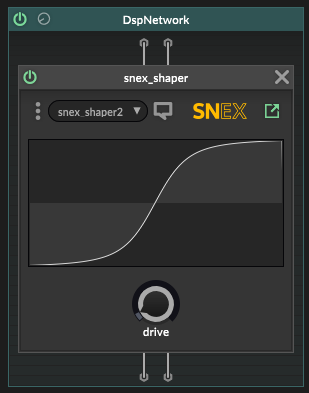 -
 O Orvillain referenced this topic on
O Orvillain referenced this topic on